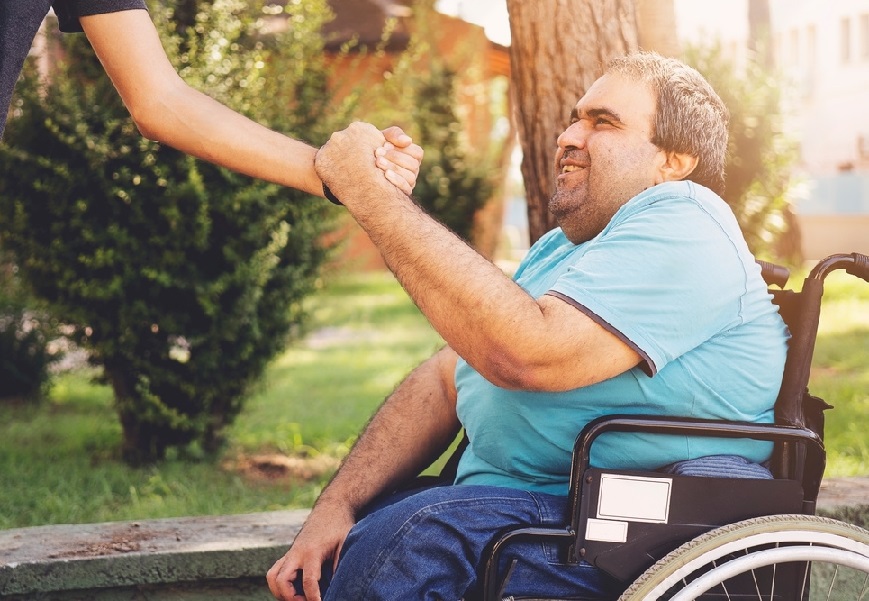Table of Contents
Introduction
Bidets are bathroom fixtures designed to cleanse and wash the genital and anal areas after using the toilet. For individuals with disabilities, the benefits of bidets extend far beyond mere convenience. Traditional toileting methods can pose significant challenges for people with disabilities, impacting their hygiene, comfort, and independence. This article explores how bidets can address these challenges and enhance the quality of life for individuals with disabilities.

Understanding Disabilities and Toileting Challenges
Types of Disabilities Affecting Toileting Independence
Physical Disabilities
Physical disabilities can encompass a wide range of conditions that affect a person’s ability to move or control their body effectively. Individuals with physical disabilities may experience challenges in accessing and using traditional toilet facilities due to mobility limitations, muscle weakness, or paralysis. These limitations can make tasks like transferring to and from the toilet, maintaining balance, and reaching hygiene areas difficult or impossible without assistance.
Cognitive Disabilities
Cognitive disabilities affect a person’s ability to process information, think, and reason. Individuals with cognitive disabilities may have difficulty understanding or remembering how to use toilet facilities properly, leading to issues with hygiene and cleanliness. Additionally, cognitive impairments can impact a person’s ability to recognize the need to use the toilet, leading to accidents or difficulties in managing toileting independently.
Sensory Disabilities
Sensory disabilities, such as visual or auditory impairments, can affect a person’s ability to perceive and navigate their environment. Individuals with sensory disabilities may face challenges in locating and accessing toilet facilities, particularly in unfamiliar or poorly designed environments. Additionally, sensory impairments can make it difficult for individuals to detect when toilet facilities are clean or to properly clean themselves after toileting, increasing the risk of hygiene-related issues.
Developmental Disabilities
Developmental disabilities encompass a range of conditions that affect a person’s physical, cognitive, or emotional development. Individuals with developmental disabilities may experience delays or difficulties in acquiring toileting skills, such as recognizing the need to use the toilet, controlling bowel and bladder functions, and performing hygiene tasks independently. These challenges can persist into adulthood, impacting a person’s ability to maintain toileting independence and hygiene.
Neurological Disabilities
Neurological disabilities result from damage or dysfunction of the nervous system, which can affect a person’s movement, coordination, and sensory perception. Conditions such as cerebral palsy, multiple sclerosis, and spinal cord injury can cause neurological impairments that affect toileting independence. Individuals with neurological disabilities may experience muscle spasms, tremors, or loss of sensation, making it challenging to control bowel and bladder functions or perform hygiene tasks effectively.

Challenges Faced by People with Disabilities in Maintaining Hygiene
Limited Mobility and Dexterity
Many people with disabilities experience limited mobility or dexterity, which can make it difficult to perform basic hygiene tasks independently. Tasks such as reaching, bending, and maneuvering in tight spaces can be challenging or impossible for individuals with mobility impairments. Similarly, limited dexterity may affect a person’s ability to manipulate small objects, such as buttons or zippers, or to effectively clean hard-to-reach areas of the body.
Difficulty Accessing Hygiene Facilities
Individuals with disabilities may encounter barriers when accessing hygiene facilities, such as public restrooms or bathing areas. These facilities may lack appropriate accommodations, such as grab bars, raised toilet seats, or accessible sinks, making it difficult or unsafe for individuals with disabilities to use them. Additionally, inaccessible or poorly designed facilities may contribute to feelings of embarrassment, frustration, or exclusion among people with disabilities.
Sensory Sensitivities
Some individuals with disabilities may have sensory sensitivities that affect their ability to tolerate certain hygiene products or activities. For example, individuals with autism spectrum disorder may be sensitive to the texture or smell of certain toiletries, making it challenging to maintain proper hygiene. Similarly, individuals with sensory processing disorders may experience discomfort or distress when exposed to certain sensory stimuli, such as water temperature or pressure, during bathing or grooming.
Assistance Requirements
Many people with disabilities rely on assistance from caregivers or support workers to maintain hygiene. However, accessing consistent and reliable assistance can be challenging, particularly for individuals living in underserved or resource-limited communities. Additionally, the need for assistance with personal care tasks can impact a person’s privacy, autonomy, and sense of dignity, leading to feelings of dependence or inadequacy.
Lack of Access to Adaptive Equipment
Access to adaptive equipment, such as shower chairs, transfer benches, or assistive devices, is essential for many individuals with disabilities to maintain hygiene independently. However, obtaining and affording these devices can be difficult, especially for individuals with limited financial resources or inadequate insurance coverage. Additionally, the availability of adaptive equipment may vary depending on geographic location, healthcare infrastructure, and government policies.
Impact of Traditional Toileting Methods on Individuals with Disabilities
Limited Accessibility
Traditional toileting methods, such as using a standard toilet and toilet paper, may not be accessible or practical for individuals with disabilities. Many standard toilets are not equipped with features like grab bars, raised seats, or adjustable heights, making them difficult or unsafe for individuals with mobility impairments to use. Additionally, the physical layout and design of public restrooms may pose accessibility barriers for people with disabilities, limiting their ability to access and use toilet facilities independently.
Inadequate Hygiene
Traditional toileting methods may not adequately address the hygiene needs of individuals with disabilities, leading to issues such as incomplete cleaning, skin irritation, and infections. The use of toilet paper alone may not effectively remove fecal matter or bacteria from the genital and anal areas, increasing the risk of urinary tract infections (UTIs), skin rashes, and other hygiene-related problems. For individuals with limited mobility or dexterity, performing thorough hygiene tasks using toilet paper alone may be challenging or impossible.
Dependence on Assistance
Many individuals with disabilities rely on assistance from caregivers or support workers to perform toileting tasks, such as wiping or cleaning themselves after using the toilet. However, dependence on assistance can impact a person’s privacy, autonomy, and sense of dignity, leading to feelings of embarrassment, frustration, or inadequacy. Additionally, inconsistent or unreliable assistance can result in hygiene-related issues, such as incomplete cleaning or urinary accidents, further compromising the individual’s well-being.
Social Stigma
The reliance on assistance for toileting tasks may contribute to social stigma and discrimination against individuals with disabilities. In many cultures, there is a lack of understanding and acceptance regarding the diverse needs of people with disabilities, leading to misconceptions and negative attitudes towards their personal care needs. As a result, individuals with disabilities may face barriers to accessing appropriate hygiene facilities and support services, exacerbating feelings of isolation, shame, and marginalization.
Impact on Quality of Life
The challenges associated with traditional toileting methods can have a significant impact on the quality of life of individuals with disabilities. Issues such as limited accessibility, inadequate hygiene, dependence on assistance, and social stigma can affect a person’s physical health, emotional well-being, and overall independence. Without access to inclusive and accessible toileting solutions, individuals with disabilities may experience diminished self-esteem, decreased social participation, and reduced quality of life.

Benefits of Bidets for People with Disabilities
Improved Hygiene and Cleanliness
Bidets offer a more thorough and hygienic cleansing experience compared to traditional toileting methods. By using a gentle stream of water, bidets effectively remove residue and bacteria from the genital and anal areas, reducing the risk of infections and irritation. This enhanced cleanliness can contribute to improved skin health and overall well-being.
Reduced Risk of Infection and Irritation
Thorough Cleansing
Bidets provide a more thorough and hygienic cleansing experience compared to traditional toileting methods, such as using toilet paper alone. The gentle stream of water from a bidet effectively removes residue and bacteria from the genital and anal areas, reducing the risk of infections and irritation. Unlike toilet paper, which may smear fecal matter or leave behind bacteria, bidets offer a comprehensive cleaning solution that helps maintain optimal hygiene.
Prevention of Urinary Tract Infections (UTIs)
Urinary tract infections (UTIs) are a common concern for individuals with disabilities, particularly those who have difficulty with hygiene maintenance. The use of bidets can help prevent UTIs by ensuring thorough cleaning of the genital area after urination. By removing bacteria and reducing the risk of contamination, bidets help maintain a healthy urinary tract and minimize the likelihood of UTIs occurring.
Reduction of Skin Irritation
Individuals with disabilities may be more susceptible to skin irritation and discomfort due to factors such as limited mobility, incontinence, and sensitivity to certain hygiene products. Traditional toileting methods, such as using rough toilet paper or wipes, can exacerbate skin irritation and contribute to conditions such as dermatitis or rashes. Bidets offer a gentle and non-abrasive cleaning solution that minimizes friction and irritation, promoting healthier skin and greater comfort.
Enhanced Comfort and Dignity
Using a bidet can enhance comfort and dignity for individuals with disabilities by providing a more pleasant and hygienic toileting experience. Unlike traditional methods that may be uncomfortable or messy, bidets offer a soothing and refreshing cleansing solution that promotes a sense of cleanliness and well-being. By reducing the risk of infections and irritation, bidets help individuals feel more confident and comfortable in their daily hygiene routines, enhancing their overall sense of dignity and self-esteem.
Promotion of Independence
For individuals with disabilities who may rely on assistance for toileting tasks, bidets offer a greater degree of independence and autonomy. By providing a means for individuals to clean themselves effectively without assistance, bidets empower individuals to take control of their personal hygiene and maintain a greater level of independence in their daily lives. This increased autonomy can contribute to improved self-esteem, confidence, and quality of life for individuals with disabilities.
Enhanced Comfort and Dignity
Using a bidet can promote a greater sense of comfort and dignity for individuals with disabilities. Unlike abrasive toilet paper, which can cause discomfort and chafing, bidets offer a gentle and soothing cleansing experience. This can help individuals feel more comfortable and confident in their daily hygiene routines, enhancing their overall sense of dignity and well-being.

Case Studies and Personal Experiences
Interviews with Individuals with Disabilities Who Use Bidets
To understand the impact of bidets on the lives of individuals with disabilities, we conducted interviews with several users. One participant, who has mobility impairments, shared how using a bidet has transformed their daily routine. “Before using a bidet, I struggled with maintaining hygiene after using the toilet,” they explained. “Now, with the help of a bidet, I feel cleaner and more confident in my ability to take care of myself.”
Testimonials from Caregivers and Healthcare Professionals
Caregivers and healthcare professionals also recognize the benefits of bidets for individuals with disabilities. “Bidets offer a practical and hygienic solution for individuals who may have difficulty with traditional toileting methods,” says Sarah, a home care aide. “I’ve seen firsthand how bidets can improve the quality of life for my clients, providing them with greater independence and dignity.”
Real-Life Examples Illustrating the Impact of Bidets on Daily Living
In addition to interviews and testimonials, real-life examples further highlight the positive impact of bidets on daily living. Take the case of John, a wheelchair user who struggled with maintaining hygiene due to limited mobility. After installing a bidet in his bathroom, John experienced a newfound sense of independence and confidence. “The bidet has made such a difference in my life,” he shares. “I no longer have to rely on others for assistance, and I feel cleaner and more comfortable than ever before.”

Addressing Concerns and Misconceptions
Cost-Effectiveness of Bidet Installation and Maintenance
Initial Investment
While the initial cost of installing a bidet may seem daunting to some, it is important to consider the long-term cost-effectiveness of this investment. Bidet attachments or seats typically range in price from around $30 to $500, depending on the features and quality. While this may represent a significant upfront expense for some individuals, it is important to consider the potential savings over time.
Savings on Toilet Paper
One of the primary benefits of using a bidet is the reduction in toilet paper usage. Bidets use water to clean the genital and anal areas after toileting, eliminating the need for excessive toilet paper. This can result in significant savings on toilet paper costs over time, particularly for individuals with disabilities who may require larger quantities of toilet paper for thorough cleaning.
Environmental Impact
In addition to cost savings, using a bidet can also have positive environmental benefits. The production and disposal of toilet paper contribute to deforestation, water pollution, and waste generation. By reducing reliance on toilet paper, bidets help conserve natural resources and minimize environmental impact. This aligns with the growing trend towards sustainability and eco-conscious living.
Minimal Maintenance Costs
Bidets typically require minimal maintenance, which can help offset the initial investment over time. Most bidet attachments or seats are easy to install and do not require professional assistance. Additionally, bidets do not have ongoing maintenance costs beyond occasional cleaning and maintenance of the unit. This can result in further savings compared to traditional toileting methods, which may require regular purchases of toilet paper and hygiene products.
Health Benefits
In addition to cost savings, bidets offer potential health benefits that can translate into long-term savings on healthcare expenses. By promoting better hygiene and reducing the risk of infections and irritation, bidets can help prevent costly medical conditions such as urinary tract infections (UTIs) and skin disorders. This can result in savings on healthcare expenses associated with treatment and management of these conditions.

Environmental Benefits Compared to Traditional Toilet Paper
Reduction in Paper Consumption
One of the most significant environmental benefits of bidets is the reduction in paper consumption. Traditional toilet paper production relies on the harvesting of trees, leading to deforestation and habitat loss. By reducing reliance on toilet paper, bidets help conserve forests and preserve biodiversity. This aligns with global efforts to combat deforestation and mitigate climate change.
Water Conservation
While bidets use water for cleansing, they typically require far less water than the production of toilet paper. The manufacturing process for toilet paper requires significant amounts of water for pulp production, processing, and transportation. By using bidets, individuals can reduce their water footprint and contribute to water conservation efforts. Additionally, some bidet models offer water-saving features, such as adjustable water pressure and flow rates, further minimizing water usage.
Reduction in Waste Generation
The use of bidets also helps reduce waste generation associated with toilet paper usage. Each year, billions of rolls of toilet paper are consumed globally, resulting in significant amounts of waste that end up in landfills or waterways. By using bidets, individuals can reduce their contribution to waste streams and help alleviate the burden on waste management systems. Additionally, bidet attachments or seats are typically durable and long-lasting, further reducing the need for disposable products.
Energy Savings
In addition to reducing paper consumption and waste generation, bidets offer potential energy savings compared to traditional toilet paper production. The manufacturing process for toilet paper involves energy-intensive processes such as pulping, drying, and transportation. By using bidets, individuals can reduce the energy consumption associated with toilet paper production and transportation, helping to mitigate greenhouse gas emissions and combat climate change.
Promotion of Sustainable Living
Overall, the use of bidets promotes sustainable living practices by reducing resource consumption, waste generation, and environmental impact. By incorporating bidets into their daily routines, individuals can contribute to a more sustainable future for generations to come. Additionally, the adoption of bidets can help raise awareness about the environmental benefits of alternative toileting solutions and inspire others to make eco-friendly choices in their own lives.
Addressing Cultural Barriers and Stigma
In some cultures, bidets may carry stigma or be perceived as unnecessary. However, by educating individuals about the practical benefits of bidets, we can help overcome cultural barriers and promote acceptance. Emphasizing the hygiene, comfort, and independence benefits of bidets can encourage more widespread adoption and usage among people with disabilities and beyond.

Recommendations and Conclusion
Advocacy for Bidet Accessibility in Public Spaces and Facilities
To promote inclusivity and accessibility, there is a need for greater advocacy and awareness regarding bidet accessibility in public spaces and facilities. By advocating for the installation of bidets in public restrooms, we can ensure that individuals with disabilities have access to the same level of hygiene and comfort as their able-bodied counterparts.
Education and Awareness Campaigns for People with Disabilities and Caregivers
Education and awareness campaigns are essential for empowering individuals with disabilities and their caregivers to make informed choices about toileting solutions. By providing information about the benefits of bidets and how to access them, we can help improve the quality of life for people with disabilities and enhance their independence and dignity.
Key Benefits and Potential Impact on Quality of Life
Bidets offer a wide range of benefits for individuals with disabilities, including improved hygiene, increased independence, and enhanced comfort and dignity. By addressing concerns and misconceptions, advocating for accessibility, and promoting education and awareness, we can help ensure that individuals with disabilities have access to the toileting solutions they need to thrive.
In conclusion, the benefits of bidets for people with disabilities are undeniable. By providing a more hygienic, comfortable, and dignified toileting experience, bidets can significantly improve the quality of life for individuals with disabilities. As we strive for greater inclusivity and accessibility in our communities, let us continue to promote the adoption of inclusive toileting solutions that meet the diverse needs of all individuals.
